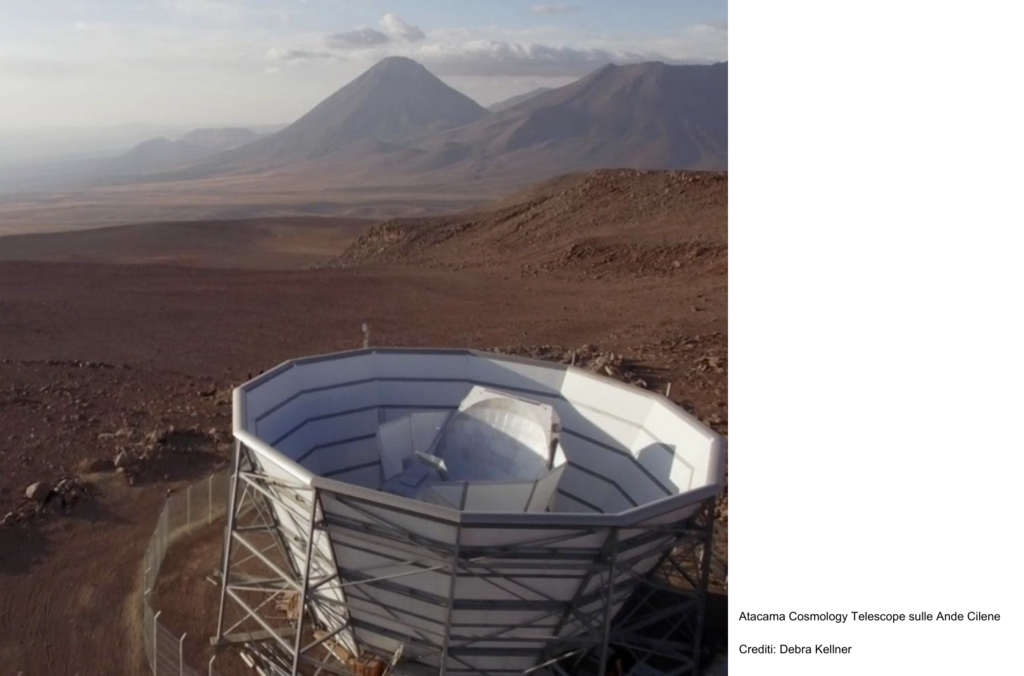
New high-definition images of the early universe from the Atacama Cosmology Telescope in the Chile’s desert
The collaboration of the Atacama Cosmology Telescope (ACT) experiment, an international project located at 5200 m in the Atacama Desert in Chile, and involving, in Italy, the groups of Elia Battistelli of Sapienza University of Rome (also comprising Giovanni Isopi, Eleonora Barbavara and Valentina Capalbo) and Federico Nati of the University of Milano-Bicocca, subjected the standard model of cosmology to a new and rigorous series of tests, demonstrating its extraordinary robustness. The new images of the early universe show the details of the first light to emerge from the dawn of the Universe with unprecedented clarity, revealing the formation of the ancient hydrogen and helium clouds that would soon become the first stars and galaxies.
The clearest images from the infancy of the universe
New research by the Atacama Cosmology Telescope (ACT) collaborative project produced the clearest images ever obtained of the early universe, from the most distant cosmic time humanity has ever had access to. Measuring light that travelled more than 13 billion years before reaching the telescope located in the Chilean Andes, these images reveal the universe when it was about 380,000 years old - the equivalent of photographs of a newborn baby in a mature cosmos.
‘We are observing the first steps towards the formation of the oldest stars and galaxies,’ says Suzanne Staggs, director of ACT and professor of physics at Princeton University. 'And we don't just see light and dark, but also the polarisation of light at high resolution. This is a distinctive feature that differentiates ACT from Planck and other previous telescopes.’
New images of the cosmic microwave background (CMB) provide higher resolution than those obtained more than a decade ago by the Planck Space Telescope. By measuring both the intensity and polarisation of the light with ACT, we now have a second high-fidelity image of the same cosmic moment. The polarisation image reveals the detailed movement of matter in cosmic infancy.
‘Before we could see where things were, now we can also see how they move,’ Staggs says. ‘Just as the tides reveal the presence of the Moon, the movement tracked by the polarisation of light tells us how strong the gravitational pull was in different regions of space.’
‘In the first few hundred thousand years after the Big Bang,’ explains Elia Battistelli, professor of physics at Sapienza University of Rome, ’the primordial plasma was so hot that light could not propagate freely, making the universe effectively opaque. The CMB represents the first stage in the history of the universe that we can observe'.
‘The images provide an extraordinarily detailed view of the variations, however small, in the density and velocity of gases. What look like fuzzy clouds in the intensity of light are actually denser and less dense regions in a sea of hydrogen and helium - hills and valleys stretching for millions of light years,’ adds Federico Nati, a professor at the University of Milan-Bicocca. ‘In the billions of years since, gravity has attracted the denser regions of gas, giving rise to stars and galaxies.’
These detailed images of the fledgling universe are helping scientists answer long-standing questions about the origins of the cosmos. ‘By looking at that time, when everything was much simpler, we can reconstruct the story of how the universe evolved to the complexity we see today,’ says Jo Dunkley, a professor of physics and astrophysical sciences at Princeton and head of ACT's analysis.
‘We have accurately measured that the observable universe stretches almost 50 billion light years in all directions and contains an amount of mass equivalent to almost 2 trillion trillion Suns,’ says Erminia Calabrese, professor of astrophysics at Cardiff University. Of this, only a fraction represents normal matter - the kind we can observe and measure. The rest is dark matter and dark energy, the mysterious components that permeate the cosmos.
The Hubble Tension
In recent years, cosmologists have obtained measurements in slight but clear disagreement on the Hubble constant, a parameter in cosmological theory that measures the rate of expansion of space. Measurements based on cosmic background radiation consistently indicate an expansion rate of 67-68 km/s/Mpc, while measurements of nearby galaxies suggest a higher value of up to 73-74 km/s/Mpc. The new ACT data confirm the lower value with even greater precision.
One of the main objectives of the study was to test alternative models that could explain the discrepancy, however, the ACT data show no evidence of new particles or effects not predicted by the standard model and further narrow the field of possible alternatives.
The future of cosmology
The cosmic background radiation measured by ACT carries extremely weak signals that are very difficult to isolate from possible contamination. ‘To obtain these new images, we carried out a five-year exposure with a telescope sensitive to millimetre wavelengths,’ explains Mark Devlin, deputy director of the project. ACT completed its observations in 2022 and attention is now shifting to the more advanced Simons Observatory, located in the same area of the Atacama Desert in Chile, for which Federico Nati at the University of Milan-Bicocca is leading an ambitious calibration programme using drone-borne artificial stars, thanks to the prestigious European ERC Advanced funding.
This research is supported by the U.S. National Science Foundation (AST-0408698, AST-0965625 and AST-1440226 for the ACT project, as well as grants PHY-0355328, PHY-0855887 and PHY-1214379), Princeton University, the University of Pennsylvania and a grant from the Canada Foundation for Innovation. The project is led by Princeton University and the University of Pennsylvania, with 160 collaborators from 65 institutions. In Italy, the activities of F. Nati's group at the University of Milan Bicocca are supported by European ERC funding, POLOCALC, 101096035. ACT operated from 2007 to 2022.
Further Information
Elia Stefano Battistelli
Department of Physics
Giovanni Isopi
Department of Physics
Eleonora Barbavara
Department of Physics
eleonora.barbavara@uniroma1.it
Valentina Capalbo
Department of Physics





